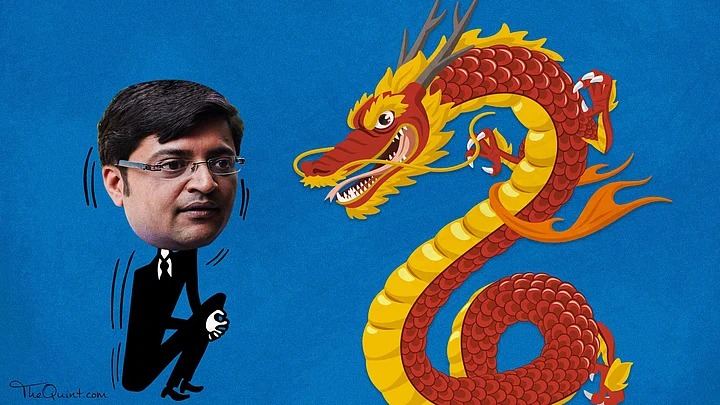Where’s Arnab Goswami when you need his outrage the most? When the Nation needs to know urgently? When the burning questions simply refuse to stop burning?
If Pakistan was to so much as sneeze in India’s direction, the country’s trigger-happy conscience-keeper draws out the cavalry – Major Gaurav Arya, Mahroof Raza, General (retd) GD Bakshi and the token Pakistani punching bag sitting in on his own intellectual demolition.
Why then, is this primetime warmongering absent among english news channels when it comes to China? Certainly, not for lack of #Provocation.
Here goes, in Arnab style...
#Provocation 1: On 6 June, Chinese bulldozers destroyed two bunkers set up by India in 2012 in Lalten in the Doklam Plateau.
#Provocation 2: This was followed by a standoff between the troops of both countries with PLA and Indian Army sending immediate reinforcements.
#Provocation 3: At the flag meeting that followed, China asked Indian troops to withdraw from the Doklam region.
Biggest #Provocation 4: China refused to allow the entry of Kailash Mansarovar pilgrims into its territory through the Nathu La Pass on the Sikkim border.
The issue at hand, is the construction of a road by the Chinese through an 89 sq km pasture called the Doklam plateau. A Chinese road through this strategically located trijunction with Bhutan and India is seen as a threat by India to its so-called “chicken neck” sector.
Despite the Indian establishment standing its ground on Doklam, China’s official dailies have hinted at escalation with hard-hitting editorials taking an aim at India. In fact, the Chinese media goes Arnab on the Indian establishment each time they react to any border skirmish. One of them, Global Times, asked Indian troops to move out of the Sikkim sector “with dignity or be kicked out”.
If New Delhi believes that its military might can be used as leverage in the Donglang area (referred to as Dokalam or Dok La), and it is ready for a two-and-a-half front war, we have to tell India that the Chinese look down on their military power.Global Times, Chinese daily
A statement even instructed India to “back down” and “learn from the historical lessons of the 1962 war”. Video play outs on subway stations in Beijing are also believed to be showing programs on India’s military capabilities.
But our “nationalist” anchors have shown remarkable restraint despite such pointed anti-national statements.
Historical Baggage
The obvious reason for that, is because the Indian people don’t share historical baggage with China. India has won all three wars fought against Pakistan and continues to be viewed as a hyphenated entity from the global perspective.
TRPs
This history also makes the standoff with Pakistan a lot more personal, a lot more emotional than with China. China on the other hand, is viewed from an economic level, as a global competitor. If Pakistan is about “Kashmir” and “terror”, China is about the “Made in China” tag. An emotional narrative is far more sale-able, watchable than an economic one.
Hindu-Muslim Binary
Additionally, China does not play into this “Hindu-Muslim” binary foisted on public imagination by the mainstream media.
You cannot tell a so-called anti-national to ‘Go back to China’. It simply does not have the same ring as “Go back to Pakistan” and would make no sense even to a troll.
China is a World Leader
If the situation between India and Pakistan were to escalate, three outsiders – namely America, Russia and China – would have good reason to settle the matter. If India were to engage in serious conflict with China, it would make the world sit up and take notice. The fact that China’s military budget is four times than that of India, makes even the Indian media draw a line in the sand.
No coverage is better than unintelligible rants, especially in a post-truth world where social media-amplified opinion can put sharp pressures on decision-making.
(At The Quint, we question everything. Play an active role in shaping our journalism by becoming a member today.)
